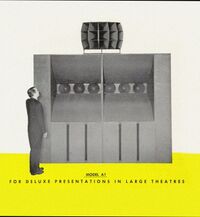Public address systems emerged in the inter-war period, using technologies developed for other purposes. Gradually, the ‘PA’ developed to the point all members of the audience could hear exactly what was intended, even in the largest venues.
From the beginnings of theatre until the first decades of the 20th century, actors and singers relied on their own vocal power, and the acoustics of the performance space, to be heard (D.01). With the development from the late 19th century onwards of the sound technologies needed to capture and amplify sound, it became possible to artificially reinforce the acoustic sound of performers - what we commonly call ‘PA’ (public address).
The three basic building blocks of all PA systems are a microphone (Q3374), an amplifier (Q3347) and a loudspeaker (Q3370). The first of these to be invented was the microphone – from the Greek words mikrós (small) and phoné (to hear). The conversion of sound into an electrical signal was first used in 1861 in the Reis Telephone developed by Johann Philipp Reis. In 1876, Emile Berliner and Thomas Edison invented the carbon microphone, which used carbon granules packed between two metal plates. The resistance between the plates changed proportionally in response to vibrations, thus modulated an electrical signal representative of those vibrations. Later microphone types gave a stronger signal, and a more accurate sound.
Throughout the 1870s and 80s, various loudspeaker-like devices existed, most notably on Alexander Graham Bell’s telephone (1876) and Edison’s phonograph (1877), but the moving coil loudspeaker, the forebear of most loudspeakers since, was invented by Oliver Lodge in 1898. It employed the same design used today: a diaphragm vibrated by a ‘voice coil’ which in turn was moved by the interaction of an electrical signal through the coil, and a magnetic field.
The final component required for a PA system came in 1906 when Lee DeForest invented the Audion, the first device capable of amplifying an electrical signal. He did this by taking a two-electrode diode and adding a third electrode so that a small current applied to one of the electrodes modulated a larger current between the other two. The small signal that came from a microphone could therefore be used to produce sound from a loudspeaker, which required a much greater current. The Audion was refined and became known as the triode, evolving into the ‘valves’ (or ‘vacuum tubes’) that were the basis of audio amplification until the development of the transistor.
The first documented example of an electric PA system being used to amplify speech and music at a public event was at Christmas 1915 at San Francisco City Hall, when Jensen and Pridhams’ Magnavox (‘great voice’) system was publicly demonstrated to an audience of 100,000 people. Despite the rudimentary system only being capable of generating about 10 watts of audio power, the use of large horn loudspeakers helped ensure that the crowd heard the music and speeches ‘with absolute distinctness’, according to reports. The Magnavox PA system used a carbon microphone, called a transmitter, mounted on a parabolic metal reflector to focus and amplify the vibrations.
Early PAs were used for live music and large events. For theatre, it was some time before PA systems could be used to amplify the actors, because early microphones were not very sensitive, and could not be positioned close enough to the performer. Gradually, techniques were developed that allowed actors to be amplified. For revue shows, where the performers would sing from a fixed position, microphones rose up out of the stage on a counterweight, and lowered again to be out of the way of the next act. Microphones were placed on short stands along the front edge of the stage for musicals from the 1950s, so they could be as close to the singers as possible. The boundary mic was a further development; placed on the stage surface, these mics gave a cleaner sound.
The amplification of actors and singers was finally transformed by the lavalier microphone, clipped onto the performer’s clothing or fixed to their head. Developed in the early 1930s, it ensured a constant distance between microphone and mouth. Once combined with a radio transmitter and receiver in the 1950s, the lavalier mic became the radio mic we know today. Actors no longer have to speak as loudly as possible; they can use the full dynamic range of their voice, and the number of people in the audience is no longer limited by the acoustic properties of the room.
Although many actors and directors are still reluctant to use sound reinforcement for drama, PA systems are increasingly used to provide a subtle but valuable improvement to intelligibility in larger theatres. For musical theatre, as well as live music, PA systems are seen as essential. With good design and skilled operation, the PA ensures everyone in the room can hear everything they are supposed to.




